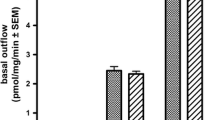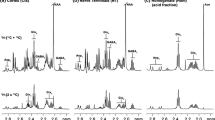Abstract
To study the effect of agents interfering with the biosynthesis and/or the K+-evoked Ca2+-dependent release of neurotransmitter glutamate, rat cerebral slices were preincubated with Krebs-Ringer-HEPES-glucose-glutamine buffer (KRH buffer), loaded withd-[3H]aspartate and superfused with the preincubation medium in the presence or in the absence of Ca2+. The difference in radioactivity release divided by the basal release per min under the two conditions represented the K+-evoked Ca2+-dependent release. The agents used were: 1) Aminooxyacetic acid (AOAA), the inhibitor of transaminases, 2) Leucine (Leu), the inhibitor of phosphate activated glutaminase (PAG), 3) NH4 +, the inhibitor of PAG, 4) Phenylsuccinic acid (Phs), the inhibitor of the mitochondrial ketodicarboxylate carrier, 5) ketone bodies, the inhibitors of glycolysis, 6) the absence of glutamine, the substrate of PAG. The results show that Leu, NH4 +, Phs and the absence of Gln significantly increase the K+-evoked Ca2+-dependent release of radioactivity by 64%, 200%, 95% and 147% respectively, indicating that these agents are inhibitors of the K+-evoked Ca2+-dependent release of glutamate. Ketone bodies and AOAA had no effect. These results indicate that the major if not the exclusive biosynthetic pathway of neurotransmitter glutamate in rat cerebral cortex is through the PAG reaction and support a model for the pathway followed by neurotransmitter glutamate i.e. glutamate formed outside the inner mitochondrial membrane has to enter the mitochondrial matrix or is formed within it from where it can be extruded to supply the transmitter pool in exchange of GABA.
Similar content being viewed by others
References
Drejer, J., Larsson, O. M., and Schousboe, A. 1983. Characterization of glutamate uptake and release processes for D-and L-aspartate in primary cultures of astrocytes and cerebellar granule cells. Neurochem. Res. 8:231–243.
Levi, G., Aloisi, F., Ciotti, M. T., Gallo, V. 1984. Autoradiographic localization and depolarization induced release of acidic amino acids in differentiating cerebellar granule cell cultures. Brain. Res. 290, 77–86.
Meier, E., Drejer, J., and Schousboe, A. 1984. GABA induces functionally active low-affinity GABA receptors on cultured cerebellar granule cells. J. Neurochem. 43:1737–1744.
Palaiologos, G., Hertz, L., and Schousboe, A. 1989. Role of aspartate aminotransferase and dicarboxylate transport for release of endogenously and exogenously supplied neurotransmitter in glutamatergic neurons. Neurochem. Res. 14:359–366.
Westergaard, N., Fosmark, H., Schousboe, A. 1991. Metabolism and release of glutamate in cerebellar granule cells cocultured with astrocytes from cerebellum or cerebral cortex. J. Neurochem. 56: 59–66.
Belhage, B., Rehder, V., Hansen, G. H., Kater, S. B., and Schousboe, A. 1992.3H-D-Aspartate release from cerebellar granule neurons is differentially regulated by glutamate-and K+-stimulation. J. Neurosc. Res. 33:436–444.
Levi, G., Patrizio, M., and Gallo, V. 1991. Release of endogenous and newly synthesized glutamate and other amino acids induced by non-N-methyl-D-aspartate receptor activation in cerebellar granule cell cultures. J. Neurochem. 56:199–206.
Levi, G., Gordon, R. D., Gallo, V., Wilkin, G. P., and Balazs, R. 1982. Putative acidic amino acid transmitters in the cerebellum. I. Depolarization induced release. Brain Res. 239:425–445.
Thangnipon, W., Kingsbury, A. E., Webb, M., and Balazs, R. 1983. Observations on rat cerebellar cells in vitro: Influence of substratum, potassium concentration and relationship between neurons and astrocytes. Dev. Brain Res. 11:177–189.
Pellegrini-Giampietro, D. E., Cherici, G., Alesiani, M., Carla, V., and Moroni, F. 1988. Excitatory amino acid release from rat hippocampal slices as a consequence of free-radical formation. J. Neurochem. 51:1960–1963.
Nielsen, E. Ø., Aarslew-Jensen, M., Diemer, N. H., Krogsgaard-Larsen, P., and Schousboe, A. 1989. Baclofen-induced, calcium-dependent. stimualtion of in vivo release of D-[3H]-aspartate from rat hippocampus monitored by intra-cerebral microdialysis. Neuchem. Res. 14:421–425.
Garthwaite, G., and Garthwaite, J. 1985. Sites of D-[3H]-Aspartate accumulation in mouse cerebellar slices. Brain Res. 343:129–136.
Rotashner, S. J., and Gerard, D. 1983. Kainate-enchanced release of D-[3H]-aspartate from cerebral cortex and striatum: Reversal by baclofen and pentobarbital. J. Neurochem. 40:1548–1557.
Dumlop, J., Grieve, A., Damgaard, I., Schousboe, A. and Griffiths, R. 1992. Sulphur-containing excitatory amino acid-evoked release of D-[3H]-aspartate from cultured cerebellar granule cells: The role of glutamate receptor activation coupled to reversal of the acid amino acid plasma membrane carrier. Neuroscience 50:107–115.
Nicholls, D. G. 1989. Release of glutamate, aspartate and gamma aminobutyric acid from isolated nerve terminals. J. Neurochem. 52:331–341.
Maycox, P. R., Hell, J. W., and Jahn, R. 1990. Amino acid neurotransmission: spotlight on synaptic vesicles. Trends Neurosc. 13: 33–87.
Naito, S., and Ueda, T. 1985. Characterization of glutamate uptake into synaptic vesicles. J. Neurochem. 44:99–109.
Szerb, J. C., and O'Regan, P. A. 1985. Effect of glutamine on glutamate release from hippocampal slices induced by high K+ or by electrical stimulation: Interaction with different Ca2+ concentrations. J. Neurochem. 44:1724–1731.
McMahon, H. T., and Nicholls, D. G. 1990. Glutamine and aspartate loading of synaptosomes: A reevaluation of effects on calum-dependent exciatatory amino-acid release. J. Neurochem. 54: 73–380.
Palaiologos, G., Hertz, L., and Schousboe, A. 1988. Evidence that aspartate aminotransferase activity and ketodicarboxylate carrier function are essential for biosynthesis of transmitter glutamate. J. Neurochem. 51:317–320.
Meijer, A. J., and van Dam, K. 1974. The metabolic significance of anion transport in mitochondria. Biochim. Biophys. Acta 346: 213–244.
Kauppinen, R. A., Sihra, T. S., and Nicholls, D. G. 1987. Aminooxyacetic acid inhibits the malateaspartate shuttle in isolated nerve terminals and prevents the mitochondria from utilizing glycolytic substrates. Biochim. Biophys. Acta 930:173–178.
Passarela, S., Barile, M., Atlante, A. and Quagliariello, E. 1984. Oxaloacetate uptake into rat brain mitochondria and reconstruction of the malate/oxaloacetate shuttle. Biochem. Biophys. Res. Commun. 119:1039–1046.
Passarela, S., Atlante, A., Barile, M., and Quagliariello, E. 1987. Anion transport in rat brain mitochondria: Fumarate uptake via the dicarboxylate carrier. Neurochem. Res. 12:255–264.
Lellos, V., Tselentis, V., Galanopoulos, E., Philippidis, H., and Palaiologos, G. 1991. Leucine: Effector of phosphate activated glutaminase in rat cerebral cortex. Neurochem. Res. 16:67–71.
Palaiologos, G., Koivisto, A. V., and Felig, P. 1979. Interaction of leucine, glucose and ketone metabolism in rat brain in vitro. J. Neurochem. 32:67–72.
McGivan, J. D., Bradford, N. M., Crompton, M., and Chappell, J. B. 1973. Effect of L-leucine on the nitrogen metabolism of isolated rat liver mitochondria. Biochem. J. 134:209–215.
Palaiologos, G., and Felig, P. 1978. Influence of L-leucine on glutamate dehydrogenase activity in isolated rat diaphragm. Yale J. Biol. Med. 51:19–26.
Bradford, H. F., and Ward, H. K. 1976. On glutaminase activity in mammalian synaptosomes. Brain. Res. 110:115–125.
Kvamme, E., and Lenda, K. 1982. Regulation of glutaminase by exogenous glutamate, ammonia and 2-oxoglutarate, in synaptosomal enriched preparation from rat brain. Neurochem. Res. 7: 667–678.
Rolleston, F. S. and Newsholme, E. A. 1967. Control of glycolysis in cerebral cortex slices. Biochem. J. 104:524–533.
Davies, R. 1943. Studies on the acetone butanol fermentation 4. Acetoacetic acid decarboxylase of Cl Acetobutylicum. Biochem. J. 37:230–238.
Sandberg, M., Ward, H. K. and Bradford, H. F. 1985. Effect of cortico-striate pathway lesion on the activities of enzymes involved in the synthesis and metabolism of amino acid neurotransmitters in the striatum. J. Neurochem. 4:42–47.
Hamberger, A., Chiang, G. H., Nylen, E. S., Scheff, S. W. and Cotman, C. W. 1979. Glutamate as a CNS transmitter. I. Evaluation of glucose and glutamine as precursors for the synthesis of preferentially released glutamate. Brain Res. 168:513–530.
Shank, R. P., and Aprison, M. H. 1981. Present status and significance of the glutamine cycle in neural tissues. Life Sci. 28:837–842.
Ward, H. K., Thanki, C. M. and Bradford, H. F. 1983. Glutamine and glucose as precursors of transmitter amino acids: Ex vivo studies. J. Neurochem. 40:855–860.
Yudkoff, M., Nissim, I., Nelson, D., Lin, Z-P., Erecinska, M. 1991. Glutamate dehydrogenase reaction as a source of glutamic acid in synaptosomes. J. Neurochem. 57:153–160.
Kvamme, E. 1983. Glutaminase (PAG). Pages 51–67, in Hertz, L., Kvamme, E., McGeer, E. G. and Schousboe, A. (eds), Glutamine, Glutamate and GABA in the Central Nervous System. Neurology and Neurobiology, Vol. 7, Alan R. Liss, Inc., NY.
Shank, R. P., Bennet, G. S., Freitag, S. D., Campbell, G. L., and Utter, M. F. 1985. Pyruvate carboxylase: An astrocyte-specific enzyme implicated in the replenishment of amino acid neurotransmitter pools. Brain Res. 329:364–367.
Kihara, M., and Kubo, T. 1989. Aspartate aminotransferase for synthesis of transmitter glutamate in the medulla oblongata: Effect of aminooxyacetic acid and 2-oxoglutarate. J. Neurochem. 52: 1127–1134.
Passarella, S., Atlante, A., Barile, M., and Quagliariello, E. 1984. Carrier mediated GABA translocation into rat brain mitochondria. Biochem. Biophys. Res. Commun. 121:770–778.
Christensen, T. H., Bruhn, T., Diemer, N. H., and Schousboe, A. 1991. Effect of phenylsuccinate on potassium-and ischemia-induced release of glutamate in rat hippocampus monitored by microdialysis. Neurosci. Lett. 134:71–74.
Author information
Authors and Affiliations
Rights and permissions
About this article
Cite this article
Georgopoulos, A., Svarna, R. & Palaiologos, G. Regulatory sites and effectors ofd-[3H]aspartate release from rat cerebral cortex. Neurochem Res 20, 45–49 (1995). https://doi.org/10.1007/BF00995151
Accepted:
Issue Date:
DOI: https://doi.org/10.1007/BF00995151




